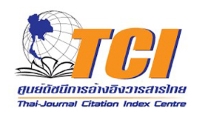JOURNAL DETAIL
Controlling Maize Weevil (Sitophilus zeamais) using a Radio Frequency Heating Prototype for Small and Medium Enterprises
Paper Type |
Contributed Paper |
Title |
Controlling Maize Weevil (Sitophilus zeamais) using a Radio Frequency Heating Prototype for Small and Medium Enterprises |
Author |
Apichaya Jakkoksung, Parichat Theanjumpol, Viboon Changrue, Yaowaluk Chanbang and Nadthawat Muenmanee |
Email |
nadthawat.mu@cmu.ac.th |
|
Abstract: Radio frequency (RF) heating was applied to control insects due to rapid volumetric heating. RF heating was designed to fit small and medium enterprises with a maximum capacity of 200 kg of milled rice per hour. The system was a continuous-type machine. The first experiment identified the most tolerant stage of maize weevil, Sitophilus zeamais, infesting 1 kilogram of milled rice in a polyethylene (PE) bag. The samples were treated with a 27.12 MHz RF and an electric power of 370 and 380 volts for 3 min. Adult maize weevil was the most tolerant stage to RF heat treatment, while egg, larval and pupal stages showed 100% mortality to RF at 380 volts for 3 min. The second experiment examined the influence of packaging materials between PE and polypropylene (PP) bags (75 μm thickness) on the mortality of maize weevil. Both packagings were exposed to RF at 370, 380, 390 and 400 volts for 3 min, and the temperature of rice kept in PP bags was 76.74±14.96, 78.09±12.45, 86.15±6.90 and 86.44±7.18°C, respectively. It was higher than in the PE bags with temperatures of 64.82±3.44, 65.14±3.18, 69.11±3.31 and 69.02±3.64°C, respectively. The third experiment identified the best combination of temperature and exposure time for RF to control the adult stage of maize weevil. Complete control of maize weevil infesting milled rice was found using the RF heat treatment for 4 min with an electric power of 380 volts. In terms of heated rice quality, there was no significant difference (P>0.05) in chalkiness or moisture content, but kernel fissuring increased with increasing RF exposure time. |
|
Article ID |
e2024069 |
Received Date |
2024-02-07 |
Revised Date |
2024-07-03 |
Accepted Date |
2024-07-18 |
Full Text |
Download |
Keyword |
radio frequency, milled rice quality, polyethylene bag, polypropylene bag |
Volume |
Vol.51 No.5 (September 2024) |
DOI |
https://doi.org/10.12982/CMJS.2024.069 |
Citation |
Jakkoksung A., Theanjumpol P., Changrue V., Chanbang Y. and Muenmanee N., Controlling Maize Weevil (Sitophilus zeamais) using a Radio Frequency Heating Prototype for Small and Medium Enterprises, Chiang Mai Journal of Science, 2024; 51(5): e2024069. DOI 10.12982/CMJS.2024.069. |
| View:2,056 Download:782 | |
Copyrights © Since 2021 All Rights Reserved by Chiang Mai Journal of Science










